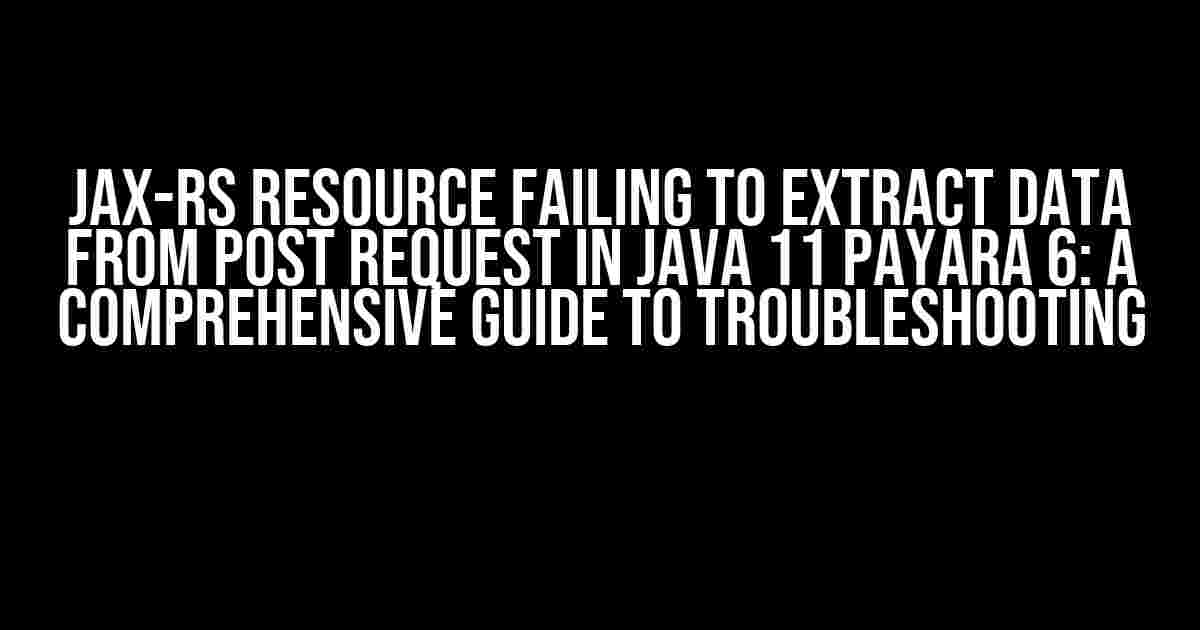Are you stuck with a JAX-RS resource that refuses to extract data from a POST request in Java 11 Payara 6? Don’t worry, you’re not alone! In this article, we’ll dive deep into the world of JAX-RS, explore common pitfalls, and provide step-by-step solutions to get your resource up and running smoothly.
The Symptoms: What’s Going Wrong?
Before we start troubleshooting, let’s identify the typical symptoms of this issue:
- Your JAX-RS resource is deployed successfully, but when you send a POST request, the data is not extracted.
- You’re using Java 11 and Payara 6 as your application server.
- You’ve double-checked your code, and everything seems correct, but the data is still not being extracted.
Understanding JAX-RS and POST Requests
Before we dive into the troubleshooting process, let’s review some JAX-RS basics:
JAX-RS (Java API for RESTful Web Services) is a specification for building RESTful web services in Java. It provides a set of annotations and APIs for building web services that conform to the REST architectural style.
When building a JAX-RS resource, you typically use the `@POST` annotation to indicate that a method handles a POST request. The method’s parameters are annotated with `@FormParam` or `@RequestBody` to specify how the data should be extracted from the request.
@Path("/users")
public class UserResource {
@POST
@Consumes(MediaType.APPLICATION_FORM_URLENCODED)
public Response createUser(@FormParam("username") String username, @FormParam("password") String password) {
// Create user logic here
return Response.ok("User created successfully!").build();
}
}
Troubleshooting Steps
Now that we’ve covered the basics, let’s go through a series of troubleshooting steps to identify and fix the issue:
Step 1: Check the Request Data
Verify that the request data is being sent correctly. Use tools like Postman, cURL, or your browser’s developer tools to inspect the request:
- Check the request method (should be POST).
- Verify the request URL (should match the `@Path` annotation).
- Inspect the request headers (should include `Content-Type: application/x-www-form-urlencoded` or similar).
- Check the request body (should contain the data you’re trying to extract).
Step 2: Verify JAX-RS Configuration
Make sure JAX-RS is properly configured in your application:
- Check that you’ve added the `@javax.ws.rs.ApplicationPath` annotation to your JAX-RS application class:
- Verify that the JAX-RS servlet is properly registered in your `web.xml` file (if using a WAR deployment):
- Check that you’ve added the necessary JAX-RS dependencies to your `pom.xml` file (if using Maven):
- Verify that the method is annotated with `@POST` and the correct `@Consumes` media type.
- Check that the method parameters are annotated correctly (e.g., `@FormParam`, `@RequestBody`, etc.).
- Verify that the method’s return type is correct (e.g., `Response` or a custom response object).
- Check for multiple `@Consumes` annotations with different media types.
- Verify that there are no `@Produces` annotations that might interfere with the request processing.
- Ensure that there are no conflicting `@Path` annotations on the class or method.
- Check for any custom `ContainerRequestFilter` or `ContainerResponseFilter` implementations.
- Verify that there are no `ReaderInterceptor` or `WriterInterceptor` implementations that might be altering the request or response.
- Verify the request data and JAX-RS configuration.
- Inspect the resource method and annotations.
- Check for conflicting annotations and middleware interference.
- Enable debug logging to get more insights.
@javax.ws.rs.ApplicationPath("api")
public class MyApplication extends Application {
// ...
}
<servlet>
<servlet-name>jerseyServlet</servlet-name>
<servlet-class>org.glassfish.jersey.servlet.ServletContainer</servlet-class>
<init-param>
<param-name>jersey.config.server.provider.packages</param-name>
<param-value>com.example.myapp</param-value>
</init-param>
<load-on-startup>1</load-on-startup>
</servlet>
<dependencies>
<dependency>
<groupId>org.glassfish.jersey.containers</groupId>
<artifactId>jersey-container-servlet-core</artifactId>
<version>2.31</version>
</dependency>
<dependency>
<groupId>org.glassfish.jersey.media</groupId>
<artifactId>jersey-media-json-binding</artifactId>
<version>2.31</version>
</dependency>
</dependencies>
Step 3: Inspect the Resource Method
Examine the resource method that’s supposed to extract the data:
@POST
@Consumes(MediaType.APPLICATION_FORM_URLENCODED)
public Response createUser(@FormParam("username") String username, @FormParam("password") String password) {
// Create user logic here
return Response.ok("User created successfully!").build();
}
Step 4: Check for Conflicting Annotations
Make sure there are no conflicting annotations on the resource method or class:
Step 5: Test with a Simple Resource
Create a simple JAX-RS resource to test the basic functionality:
@Path("/test")
public class TestResource {
@POST
@Consumes(MediaType.TEXT_PLAIN)
public Response test(@RequestBody String message) {
return Response.ok("Received message: " + message).build();
}
}
Send a POST request to this resource with a simple text payload. If this works, it might indicate a problem with your original resource.
Step 6: Enable JAX-RS Debug Logging
Enable debug logging for JAX-RS to get more insights into the request processing:
<logger name="org.glassfish.jersey" level="DEBUG"/>
This will log detailed information about the request and response processing. Inspect the logs to see if there are any errors or warnings related to the request data extraction.
Step 7: Check for Middleware Interference
Verify that there are no middleware components interfering with the request processing:
Conclusion
Troubleshooting a JAX-RS resource that fails to extract data from a POST request can be challenging, but by following these steps, you should be able to identify and fix the issue. Remember to:
By following these steps, you should be able to resolve the issue and get your JAX-RS resource working as expected.
| Symptom | Troubleshooting Step |
|---|---|
| Data not extracted from POST request | Check request data and JAX-RS configuration (Step 1 & 2) |
| JAX-RS configuration issues | Verify JAX-RS configuration (Step 2) |
| Method annotations incorrect | Inspect resource method annotations (Step 3) |
| Conflicting annotations | Check for conflicting annotations (Step 4) |
| Middleware interference | Frequently Asked Question
Get the inside scoop on resolving JAX-RS resource failing to extract data from post request in Java 11 Payara 6! Why is my JAX-RS resource not extracting data from the POST request?This issue often occurs when the Content-Type header is not set correctly in the request. Make sure the client is sending the request with the correct Content-Type, such as application/json or application/xml, depending on the type of data being sent. Verify that the JAX-RS resource is also configured to consume the correct media type. How do I enable debug logging to troubleshoot the issue?In Payara 6, you can enable debug logging for JAX-RS by adding the following configuration to your `server-config` file: ` What if I’m using a custom JSON provider, like Jackson or MOXy?When using a custom JSON provider, ensure that it is correctly configured and registered with the JAX-RS application. Check that the provider is properly registered in the `web.xml` file or through a `@Provider` annotation. Also, verify that the custom provider is compatible with the version of Java and Payara 6 you are using. Can I use a debugger to inspect the request and response objects?Yes, you can use a debugger like IntelliJ IDEA, Eclipse, or Visual Studio Code to inspect the request and response objects. Set a breakpoint in your JAX-RS resource method and inspect the `HttpServletRequest` and `HttpServletResponse` objects to verify that the data is being sent correctly. This can help you identify if the issue is with the request or response processing. What if none of the above solutions work, and I’m still stuck?Don’t worry! If none of the above solutions work, you can try enabling verbose logging, reviewing the server logs, or seeking help from the Payara 6 community or a Java/JAX-RS expert. You can also try creating a minimal, reproducible example to isolate the issue and make it easier to troubleshoot. |



